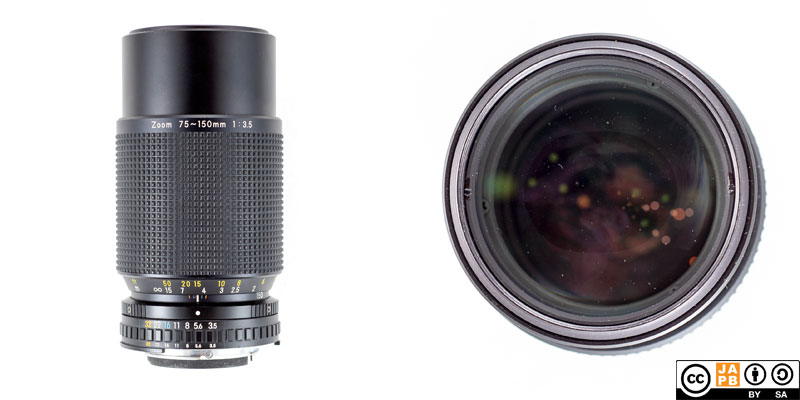Pekka Buttler, 08/2022 (updated 02/2023)

Specifications
The table below summarizes the lens’ key specifications:
| Brand: | Nikon (Nikkor) | Lens name | Series E 75-150 mm 1:3.5 |
| Focal length range 1 | 75–150 mm | Angle-of-view 2 | 31°40’–17° |
| Maximum Aperture | f/3.5 | In Production | 1980–1981 [black version] 1981–1985 [silver ring version] |
| Lens mount | Nikon F | Subfamily (if applicable) | Series E (Ai-s) |
| Length 3 | 116,4 mm | Diameter 4 | 64,7 mm |
| Filter ring diameter | 52 mm | Weight | 513 grams |
| Lens element count | 12 | Lens group count | 9 |
| Aperture blades (S/R/C) 5 | 7 S | Focus throw | 180 ° |
| Minimum focusing distance | 1 m | Maximum magnification | 1:5 |
| Has manual aperture ring | YES | Has Manual focus ring | YES |
| Aperture mechanism type | Automatic | Aperture click stops 6 | 3.5-5.6-8-11-16-22 |
Further notes:
• This lens is the only series E zoom that was introduced before 1981. Hence, this is also the only series E zoom that exists in both all black and silver ring trim.
• In the case of this lens, the differences between all-black and silver trim are purely cosmetic.
• Alike all three series E zooms, it is a one touch zoom (push-pull zoom, zooming and focusing are done using the same ring) that uses a reverse-zoom approach (to zoom closer, pull the zoom ring toward the camera). The lens’ length does not change while zooming.
• With decent close-focus abilities, the lens can find many uses.
• The lens’ dedicated hood is the HN-21, a filter thread mounted metal hood.
• The lens’ filter ring rotates when focusing.
• Series E lenses are Ai-s compatible.
A brief genealogy of Nikon SLR lens types
Nikon is undoubtedly one of the great names in 35 mm SLR photography. The Nikon F mount has been in continuous production since 1959. During that time, the mount has developed/changed in some detail, however without ever fully sacrificing compatibility.
In short (a longer version is here), the development of Nikon’s SLR lenses can be traced as follows:
• 1959–1977: Pre-Ai. Manual focus lenses that use ‘rabbit ears’ to communicate selected aperture with the camera body.
• 1977–1986: Ai and Ai-s. Manual focus lenses that may have ‘rabbit ears’ for backward compatibility, but are designed to communicate selected aperture with the camera body through indentations in base of aperture control ring.
• 1986–today: AF and AF-D. Autofocus lenses that do not have a focusing motor within the lens, but rely on the focus motor within the camera. All AF and AF-D lenses are simultaneously Ai-s lenses (they are Ai-s lenses extended with AF) 7
• 1996–today AF-S and AF-P. Autofocus lenses that have an internal focusing motor and do not rely on the body having a focusing motor.
Series E lenses are – in this respect – a minor oddity. Intended as an economy offering (E as in economy) to forestall the onslaught of 3rd party lenses, Series E lenses are technically entirely Ai-s compatible lenses. Read more on the Series E here.
While its specifications may not sound like much (especially the only 2X zoom factor), this is one of those series E lenses that has given the series E range its ‘sleeper’ reputation. Moreover, this lens is often mentioned as an exception to the ‘consumer legacy zooms are all crap’ rule.
Adapting
Besides adapting, this lens can be used natively on all current high-end Nikon dSLRs and several earlier medium-to-high-end older Nikon dSLRs 8. Likewise, if jury-gigged with rabbit ears, it can be natively used on all Nikon F-mount film cameras ever produced (without the rabbit ears, it is limited to post–1977 bodies).
Thanks to being a fully manual lens (manual aperture, manual focus), the lens can be adapted to all mirrorless cameras using a suitable dumb adapter (and such adapters are easy to find). Moreover, a wide range of special adapters (helicoid adapters, tilt/shift adapters, speed boosters) for using Nikon F lenses on most mirrorless systems are available.
Using Nikon F lenses on non-Nikon SLRs and dSLRs is likewise a distinct possibility. Thanks to the relatively generous flange focal distance of the Nikon F mount (46,5 mm), adapter rings for all dSLR mounts are available as well as for a goodly portion of film-era SLR mounts. Such rings may not allow for auto aperture, but even then the lenses can be used in stop-down metering mode.
Footnotes
- Focal length is (unless stated otherwise) given in absolute terms, and not in Full-frame equivalent. For an understanding of whether the lens is wide/tele, see ‘Angle-of-view’. ↩︎
- Picture angle is given in degrees and concerns the diagonal picture angle. Rule of thumb:
> 90 ° ==> Ultra-wide-angle
70–90 ° ==> Wide-angle
50–70 ° ==> Moderate wide-angle
40–50 ° ==> ‘Standard’ or ‘normal’ lens
20–40 ° ==> Short tele lens
10-20 ° ==> Tele lens
5-10 ° ==> Long tele lens
< 5 ° ==> Ultra-tele lens ↩︎ - Length is given from the mount flange to the front of lens at infinity. ↩︎
- Diameter excludes protrusions such as rabbit ears or stop-down levers. ↩︎
- S=straight; R=rounded; C=(almost)circular at all apertures. ↩︎
- Numbers equal aperture values on aperture ring; • intermediate click; – no intermediate click. ↩︎
- There is a further sub-class of AF-D lenses called AF-I lenses that are otherwise AF-D lenses (meaning, fully Ai-s compatible), but have an internal focus motor. Only long tele lenses were made in AF-I variants. ↩︎
- As of this writing, the following Nikon dSLRs fully support Aperture priority and manual metered modes on Nikkor Ai-s lenses: D2, D3, D4, D5, D6, D200, D300, D300s, D500, D600, D610, D700, D750, D780, D800, D800E, D810, D850, D7000, D7100, D7200 ↩︎